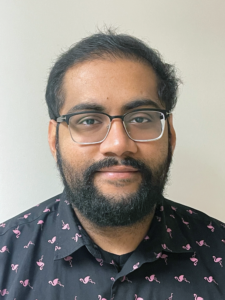Concours de communications étudiantes Anthony J. Mackay 2024 : Découvrez les finalistes de cette année

Chaque année, le Comité des étudiants et des jeunes professionnels organise, conjointement au congrès annuel de l’ACRP, un concours de communications écrites pour les étudiants. Le concours est ouvert à tous les étudiants inscrits à temps plein dans un programme relié aux sciences des rayonnements, dans un établissement d’enseignement (collège ou université) canadien.
Trois finalistes sont sélectionnés pour présenter leurs travaux au congrès lors d’une séance plénière. Les présentations seront jugées sur place et l’annonce du gagnant ou de la gagnante sera faite durant le banquet du congrès plus tard en soirée. Le gagnant ou la gagnante recevra le prix Anthony J. MacKay et un prix de 250 $ en espèces. Sa communication sera publiée dans le Bulletin de l’ACRP.
Tous les étudiants s’inscrivant au concours recevront un abonnement d’un an à l’ACRP. Les frais d’inscription au congrès (incluant un billet pour le banquet annuel) et l’hébergement pour trois nuits seront payés pour les trois finalistes.
Rencontrez les finalistes de cette année
 Meghan Sanderson
Meghan Sanderson
Physique médicale et biologique
Université McMaster
Meghan est une étudiante de premier cycle du programme de physique médicale et biologique de l’Université McMaster. Elle a terminé son stage coopératif au sein du service de radioprotection de McMaster où elle a participé à la planification et à l’exécution du projet de mise hors service du cyclotron RDS-112. Elle a également terminé sa thèse de premier cycle sur la façon d’atténuer le mouvement du cycle cardiaque dans l’imagerie par résonance magnétique de la tension de diffusion du cerveau. En dehors de ses activités universitaires, elle aime s’impliquer dans sa communauté à titre de secouriste médicale et se faire l’avocate et la mentore de femmes dans les STIM et dans le nucléaire.
Tell us a little bit about yourself.
I am a medical and biological physics co-op student at McMaster University. I am passionate about healthcare, and I love travelling. My favourite trip to date was a medical service trip to Peru. In my free time, you can find me teaching line dancing.
Share some background on your submitted work.
During my co-op placement with the McMaster Health Physics Department as a student radiation surveyor, I had the privilege of contributing to a pioneering decommissioning project. I am grateful for my time, and I learned so much working with a multidisciplinary team of engineers, architects, contractors, and the radiation safety team. The project would not have been successful without everyone’s hard work and dedication.
How did you hear about the Anthony J. MacKay Student Paper Contest?
I first heard about the student paper contest when it was recommended to me by my co-op supervisor.
What are you looking forward to most at the conference this June?
I am excited to attend my first CRPA conference, and I look forward to learning about the impactful work of my fellow participants. I am looking forward to sharing my own work and meeting others in the field.
What’s up next for you?
This summer, I’ll be working on brachytherapy research at Princess Margaret Cancer Centre in Toronto. My aspiration is to further explore this field in my future graduate studies, focusing on medical physics.
Lire le résumé de Megan : Mise hors service de l’installation cyclotron RDS-112
 Nicholas Somer
Nicholas Somer
Doctorat en génie nucléaire
Université Ontario Tech
Nicholas est un candidat au doctorat de l’Université Ontario Tech. Il a fait ses études en sciences physiques (Université de la Colombie-Britannique) et en génie nucléaire (Université Ontario Tech). Son principal domaine de recherche est le démantèlement nucléaire. Nicholas aspire à long terme à travailler dans l’industrie nucléaire en radioprotection ou en génie afin de soutenir le développement de technologies pour réduire la dose aux travailleur·se·s.
Tell us a little bit about yourself.
I am a PhD student from Ontario Tech University. My background in physics motivated me to pursue a productive career in the nuclear industry. I went from understanding the industry to wanting to help build and improve it. On the side, I am an avid cornet and trumpet player.
Share some background on your submitted work.
My research focuses on developing advanced methods to capture radionuclide aerosols produced during nuclear decommissioning and dismantlement work. The goal of capture is to reduce dose to the worker and to the environment by capturing the aerosols at the source. While there are feasible technologies to use in the field, we do not yet have an understanding of how much dose they will reduce. As such, we need to model the dose reduction based on the effectiveness of capture devices. This initial model has turned into a branch of my PhD research, in which I hope to better understand the sizing of filtration systems and how I should scale up the capture device that I am currently developing.
How did you hear about the Anthony J. MacKay Student Paper Contest?
I sought some guidance from my university’s radiation safety officer, and he recommended that I submit to this contest.
What are you looking forward to most at the conference this June?
I am a physicist and engineer by training, so radiation protection is something that is somewhat new to me. There are many people here that know a lot more about radiation protection principles, so their feedback could greatly help my work.
What’s up next for you?
I am currently wrapping up my PhD. As my research work has straddled both radiation protection and engineering, I am looking to seek employment in engineering and health physics.
Lire le résumé de Nicholas : Estimation des effets de la filtration et de la ventilation sur la dose d’aérosols inhalés par les travailleur·se·s lors du démantèlement d’installations nucléaires
 Shayenthiran (Shayen) Sreetharan
Shayenthiran (Shayen) Sreetharan
Doctorat, Sciences du rayonnement
Université McMaster (diplôme obtenu en décembre 2023)
Shayenthiran est spécialiste en radioprotection et responsable suppléant de la radioprotection au London Health Sciences Center (LHSC) et au St. Joseph’s Health Care London, à London en Ontario. Il soutient le programme de radioprotection pour les travailleur·se·s dans les deux réseaux hospitaliers.
Il a récemment obtenu son doctorat au programme de sciences du rayonnement à l’Université McMaster. Il a publié un total de 12 publications évaluées par des pairs, dont 5 publications de synthèse sur des sujets liés aux sciences du rayonnement. Il est également membre mentoré du groupe de travail 121 de la CIPR.
En dehors de ses fonctions professionnelles, il est passionné par la communication scientifique et l’éducation. Il a déjà occupé plusieurs postes en enseignement des sciences.
Tell us a little bit about yourself.
My name is Shayen Sreetharan and I am currently working and living in London, Ontario, with my wife. I completed my PhD in 2023 through the Radiation Sciences Graduate Program (“Rad Grad”) at McMaster University in Hamilton, Ontario. My graduate research investigated the effects of ionizing radiation during development in mammalian models. Outside of my graduate research, I am passionate about science education and communication. Within the technically complex field of radiation sciences (with what seems like an endless list of units for measurement of dose or exposure), I believe it is important to be able to explain these concepts in a manner that can be understood by a wide range of audiences.
Share some background on your submitted work.
My submitted work is part of my involvement with the International Commission on Radiological Protection (ICRP) as a mentee/member of ICRP Task Group 121, which is investigating the effects of ionizing radiation exposure in offspring and next generations. My role within the task group is performing a literature review regarding evidence for multi-generational (where the exposure continues into subsequent generations) and trans-generational (where there is a recovery period in later generations) effects in non-human biota.
One advantage of these non-human study models is that shorter generations allow us to investigate generational impacts of radiation exposure, which is difficult to study within humans. I am completing this work under the mentorship of Dr. Christelle Adam-Guillermin, a researcher at Institut de Radioprotection et de Sûreté Nucléaire (IRSN), France’s nuclear regulator. I applied for this mentorship position through an open call on the IRCP website. As this task group’s work aligned well with my graduate research in the field of developmental radiation biology, I was interested in contributing to this unique and fascinating concept of radiation exposure effects that may persist multiple generations following the initial exposure.
How did you hear about the Anthony J. MacKay Student Paper Contest?
I previously submitted an abstract for the student paper contest following a discussion with Dr. Diana Moscu, former CRPA President. Diana highly recommended the student paper contest as an opportunity to present my research as a graduate student.
What are you looking forward to most at the conference this June?
I am most excited to build connections and expand my network with other attendees. My goal is to learn from the other presentations and experts within the Canadian radiation protection community. It will also be my first time visiting Edmonton, and I hope to find time to explore the city!
What’s up next for you?
I am currently working as a radiation safety specialist for two hospital networks in London, Ontario. As I continue to grow in this role, I am looking to get more involved with health physics support for the organization, such as X-ray shielding applications and nuclear medicine room designations. I am also planning to apply for CRPA(R) certification in the future, and I will be working toward that by preparing for the exam and gaining experience in my current radiation protection role. In regards to the ICRP work that I submitted, our task group is continuing to review the literature and working toward a final ICRP publication on the topic.
Lire le résumé de Shayen : Effets de l’exposition aux rayonnements ionisants sur plusieurs générations dans le biote non humain
Voir les articles connexes :
Concours de communications étudiantes Anthony J. Mackay 2024 : Résumés, 7 juin 2024
Concours de communications étudiantes Anthony J. Mackay 2023, 17 mai, 2023
Gagnants du concours de communications étudiantes Anthony J. Mackay 2022, 16 février 2023
Concours de communications étudiantes Anthony J. Mackay 2019, 7 juin 2019
Concours de communications étudiantes Anthony J. Mackay 2018, 8 mai 2018
Vous voulez lire d’autres articles comme celui-ci ?
Le Bulletin de l’Association canadienne de la radioprotection (ACRP) est une publication essentielle à tout professionnel de la radioprotection du Canada. Son contenu éditorial procure aux professionnels de la radioprotection les enseignements, l’information, les conseils et les solutions utiles, tous nécessaires pour demeurer à l’avant-garde de la profession.
Abonnez-vous aujourd’hui pour que nous vous envoyions un courriel chaque fois qu’un nouveau numéro est mis en ligne. Revisitez souvent le site entre chaque numéro pour obtenir les mises à jour et consulter de nouveaux articles.
Ne ratez aucun numéro. Abonnez-vous dès aujourd’hui !
Abonnez-vous

 Meghan Sanderson
Meghan Sanderson Nicholas Somer
Nicholas Somer Shayenthiran (Shayen) Sreetharan
Shayenthiran (Shayen) Sreetharan
